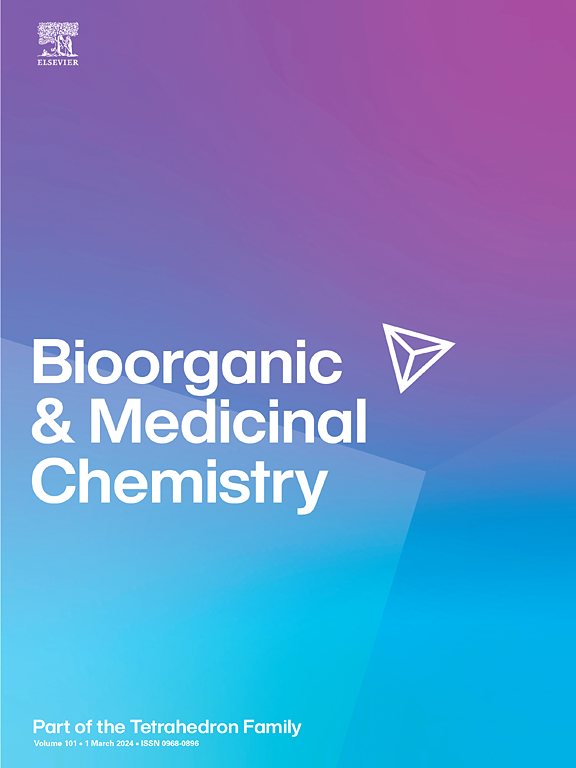CD3254的吡啶取代类似物和CBt-PMN的氟化类似物作为新型治疗药物的建模、合成和细胞评价。
IF 3.3
3区 医学
Q2 BIOCHEMISTRY & MOLECULAR BIOLOGY
引用次数: 0
摘要
制备了六种吡啶类(E)-3-(3-(1,2,3,4-四氢-1,1,4,4,6-五甲基萘-7-基)-4-羟基苯基)丙烯酸或CD3254(11),以及两种新型1-(3,5,5,8,8-五甲基萘-5,6,7,8-四氢萘-2-基)- 1h -苯并[d][1,2,3]三唑-5-羧酸(CBt-PMN或23),并与fda批准的治疗皮肤t细胞淋巴瘤(CTCL)的药物贝沙罗汀(1)一起评估了选择性维甲酸x受体(RXR)的激动作用。用1治疗通常会通过破坏或刺激其他依赖rxr的核受体和细胞通路而引起副作用。所有类似物通过建模来评估其结合RXR的能力,然后使用RXR-RXR哺乳动物-2-杂交(M2H)系统和rxre控制的转录测定在人结肠和肾细胞中进行评估。与1相比,这些类似物的EC50值以及它们在激活LXR/LXRE和甾醇调节元件结合蛋白(SREBP)启动子方面的相应有效性表明,这些化合物可能具有一系列的治疗潜力和不同的副作用。一些类似物也表现出减少的视黄酸受体(RAR)交叉信号,这意味着它们对细胞RXR的激活具有比RAR途径更高的选择性。这些结果表明,与已批准的治疗药物如化合物1相比,修饰强效的rexinoids(如CD3254)或部分激动剂(如CBt-PMN)可以改善靶受体选择性和增强效价,如本研究中的化合物26、27和28,其中这三种化合物具有与1相似的效价,但26和27的RAR和SREBP激活低于1。本文章由计算机程序翻译,如有差异,请以英文原文为准。

Modeling, synthesis and cell-based evaluation of pyridine-substituted analogs of CD3254 and fluorinated analogs of CBt-PMN as novel therapeutics
Six pyridine analogs of (E)-3-(3-(1,2,3,4-tetrahydro-1,1,4,4,6-pentamethylnaphthalen-7-yl)-4-hydroxyphenyl)acrylic acid—or CD3254 (11)—in addition to two novel analogs of 1-(3,5,5,8,8-pentamethyl-5,6,7,8-tetrahydronaphthalen-2-yl)-1H-benzo[d][1,2,3]triazole-5-carboxylic acid (CBt-PMN or 23) were prepared and evaluated for selective retinoid-X-receptor (RXR) agonism alongside bexarotene (1), an FDA-approved drug for cutaneous T-cell lymphoma (CTCL). Treatment with 1 often elicits side-effects by disrupting or provoking other RXR-dependent nuclear receptors and cellular pathways. All analogs were assessed through modeling for their ability to bind RXR and then evaluated in human colon and kidney cells employing an RXR-RXR mammalian-2-hybrid (M2H) system and in an RXRE-controlled transcriptional assay. The EC50 values for these analogs, and their corresponding effectiveness in activating both LXR/LXRE and the Sterol Regulatory Element Binding Protein (SREBP) promoter in comparison to 1, suggests that these compounds likely display a range of therapeutic potential and differential side effect profiles. Several analogs also exhibited reduced retinoic-acid-receptor (RAR) cross-signaling implying that they possess enhanced selectivity towards activation of cellular RXR versus RAR pathways. These results show that modifying potent rexinoids such as CD3254 or partial agonists such as CBt-PMN can result in improved target receptor selectivity and enhanced potency, such as compounds 26, 27 and 28 in this study, compared with approved therapeutics such as compound 1, where these three compounds exhibited similar potency as 1, but 26 and 27 lower RAR and SREBP activation than 1.
求助全文
通过发布文献求助,成功后即可免费获取论文全文。
去求助
来源期刊

Bioorganic & Medicinal Chemistry
医学-生化与分子生物学
CiteScore
6.80
自引率
2.90%
发文量
413
审稿时长
17 days
期刊介绍:
Bioorganic & Medicinal Chemistry provides an international forum for the publication of full original research papers and critical reviews on molecular interactions in key biological targets such as receptors, channels, enzymes, nucleotides, lipids and saccharides.
The aim of the journal is to promote a better understanding at the molecular level of life processes, and living organisms, as well as the interaction of these with chemical agents. A special feature will be that colour illustrations will be reproduced at no charge to the author, provided that the Editor agrees that colour is essential to the information content of the illustration in question.
 求助内容:
求助内容: 应助结果提醒方式:
应助结果提醒方式:


